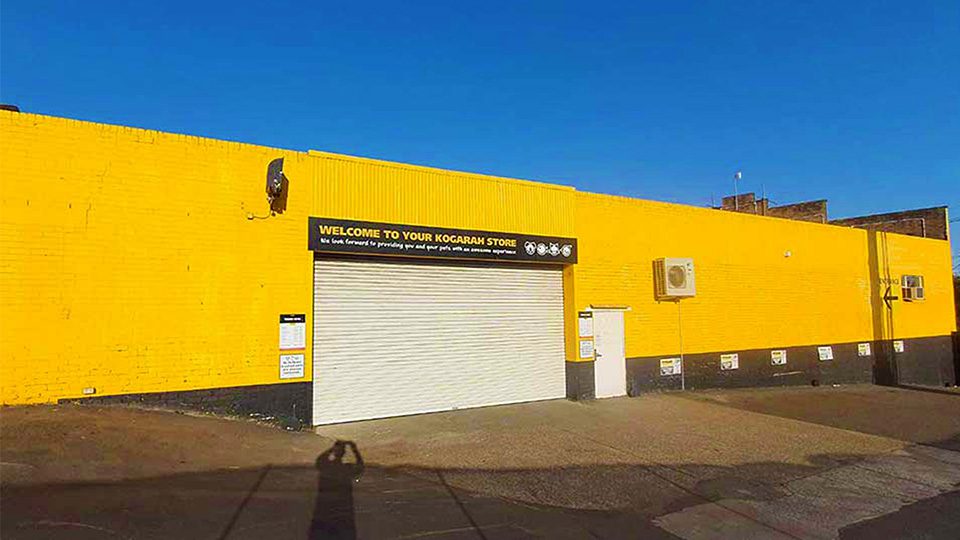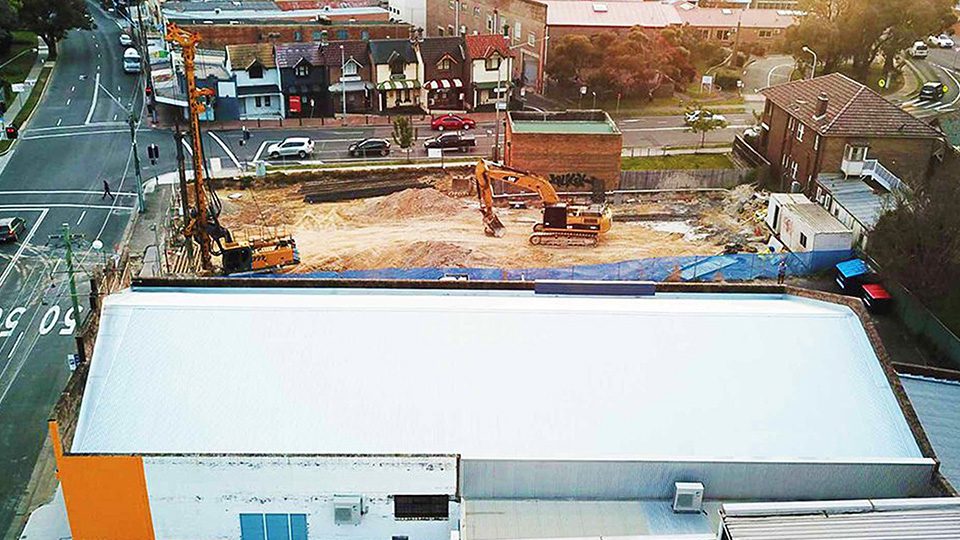JOB: Warehouse Re-Roofing
Work Done: Old Roof Removed & Replaced
contact us today or call direct 1300-564-612
Pan Civil | Chillex | Hanlon | South Pacific Laundry | Show Tech | Royal Sydney Gold Club | Warehouse Re-Roofing | Strathfield Golf Club

Side View of Warehouse

Areal View After Re-Roofing
contact us today or call direct 1300-564-612
Pan Civil | Chillex | Hanlon | South Pacific Laundry | Show Tech | Royal Sydney Gold Club | Warehouse Re-Roofing | Strathfield Golf Club
Installation
New Warehouse Roof
RVA Roofing was asked to quote a price on an occupied retail premise in Kogarah. The tenants had advised the landlord that the metal roof had extensive leaks throughout and was causing damages. The business was losing stock and the premises was quickly becoming unsafe and a dangerous place to work. The roof leaks were so prolific that serious concerns were brought up by the Tennant in regard to customer and worker safety alike. The situation was unacceptable.
It was an urgent matter that needed to be dealt with immediately. RVA Roofing was asked to make a speedy and thorough investigation of the full extent of the leaks and submit a report on the repair protocol and costs involved.
Upon inspection, it was found that the roof was in extremely poor condition. There were leaks all over the roof, and many of the now unused penetrations through the roof were also leaking. There was a large amount of water on the floor and much of the retailer’s stock was getting damaged.
The current Tennant operated a business that ran 7 days a week and involved a constant flow of foot traffic by customers and operational logistics. Shutting down for repairs was not an option with the exception of the materials delivery for safety reasons. RVA proposed a Repair Workflow System that posed little disruption to the everyday running of the business. There was very little downtime for the operating business.
contact us today or call direct 1300-564-612
Pan Civil | Chillex | Hanlon | South Pacific Laundry | Show Tech | Royal Sydney Gold Club | Warehouse Re-Roofing | Strathfield Golf Club
Navigating Commercial Roofing in Australia: A Comprehensive Guide
Commercial roofing plays a crucial role in the structural integrity and longevity of industrial buildings. As a professional in Australia, I’m here to address common questions surrounding commercial roofing, ranging from types of roofs to qualifications for roofers.
1. What are the different types of industrial roofs?
Industrial roofs come in various types, including:
- Metal Roofing: Commonly used for its durability and weather resistance.
- TPO (Thermoplastic Polyolefin) Roofing: Known for its energy efficiency and ease of installation.
- EPDM (Ethylene Propylene Diene Terpolymer) Roofing: Offers excellent durability and flexibility.
- PVC (Polyvinyl Chloride) Roofing: Resistant to chemicals and pollutants.
- Built-Up Roofing (BUR): Consists of multiple layers of bitumen and reinforcing fabrics.
2. What is the best industrial roof?
The best industrial roof depends on various factors such as climate, budget, and building requirements. Metal roofing is often considered a top choice due to its longevity, durability, and versatility across different climates.
3. Do roofers need to be licensed in Australia?
Yes, roofers in Australia must be licensed to carry out roofing work. Licensing requirements vary by state, but generally involve completing a recognized qualification and obtaining relevant certifications.
4. How long do industrial roofs last?
The lifespan of industrial roofs depends on factors like material quality, maintenance, and environmental conditions. Metal roofs can last 40-70 years, while other types like EPDM and TPO may have shorter lifespans.
5. What roof lasts 100 years?
Slate roofing is renowned for its longevity and can last over a century with proper maintenance. However, it’s less common in industrial settings due to its weight and cost.
6. What is the life expectancy of a commercial metal roof?
A commercial metal roof can last anywhere from 40 to 70 years, depending on factors like material quality and maintenance practices.
7. How much do roofers get paid in Australia?
Roofers’ salaries in Australia vary based on experience, location, and employer. On average, roofers can earn between AU$45,000 to AU$90,000 per year.
8. What qualifications do I need to be a roofer in Australia?
To work as a roofer in Australia, you typically need to complete an apprenticeship, obtain a Certificate III in Roofing, and hold relevant licenses and certifications.
9. What is the difference between a roofer and a roof plumber?
While roofers primarily focus on installing and repairing roofing materials, roof plumbers specialize in installing and maintaining roof drainage systems, including gutters and downpipes.
10. What is the most common type of commercial roof?
Metal roofing is one of the most common types of commercial roofs due to its durability, longevity, and ability to withstand various weather conditions.
11. What is the most expensive roof to install?
Slate roofing tends to be one of the most expensive options to install due to the high cost of materials and specialized labor required.
12. What type of roof is most commonly found on commercial buildings and why?
Metal roofing is commonly found on commercial buildings due to its durability, low maintenance requirements, and ability to accommodate large roof areas.
13. How many layers does a commercial roof have?
Commercial roofs may have multiple layers depending on the roofing system used. Built-up roofing (BUR) systems, for example, typically consist of several layers of bitumen and reinforcing fabrics.
14. What do industrial roofers do?
Industrial roofers are responsible for installing, repairing, and maintaining roofs on commercial and industrial buildings, ensuring they remain watertight and structurally sound.
15. What is a commercial roof?
A commercial roof is a roofing system installed on non-residential buildings, such as offices, warehouses, and retail stores, to provide protection from the elements and maintain interior comfort.
16. What is used in commercial roofing?
Various materials are used in commercial roofing, including metal, single-ply membranes (TPO, EPDM, PVC), built-up roofing (BUR), and modified bitumen.
17. What thickness is commercial roofing?
The thickness of commercial roofing materials varies depending on the type of roofing system and manufacturer specifications. For example, single-ply membranes can range from 45 to 90 mils (1.14 to 2.29 mm) in thickness.
18. What are most commercial building roofs made of?
Most commercial building roofs are made of materials such as metal, asphalt, or synthetic membranes like TPO or EPDM.
19. How much weight can a commercial roof hold?
The weight capacity of a commercial roof depends on factors like roof design, building structure, and materials used. Structural engineers determine weight limits based on these factors to ensure safety.
20. What is the minimum roof pitch for a commercial building?
The minimum roof pitch for a commercial building depends on the roofing material used. For most low-slope roofing systems, a minimum pitch of 1/4:12 (1:48) is recommended to facilitate water drainage.
21. What is the commercial length of corrugated roofing?
Corrugated roofing sheets for commercial applications typically come in standard lengths ranging from 6 to 12 meters.
22. What type of roof is most expensive?
Slate roofing is often the most expensive type of roof due to the high cost of materials and labor-intensive installation process.
23. Why do old factories have slanted roofs?
Old factories often have slanted roofs to provide proper drainage for rainwater and snow, as well as to accommodate ventilation and natural lighting needs.
24. What is best for a commercial flat roof?
Single-ply membrane roofing systems like TPO or EPDM are commonly used for commercial flat roofs due to their durability, flexibility, and ease of installation.
25. What is the most a roofer can make?
Experienced and certified roofers with specialized skills can potentially earn over AU$100,000 per year, especially in high-demand areas or during peak construction seasons.
26. How to start a roofing business in Australia?
To start a roofing business in Australia, you’ll need to register your business, obtain necessary licenses and insurance, invest in quality equipment, and build a reputation through quality work and customer satisfaction.
27. Is roofing a trade in Australia?
Yes, roofing is considered a trade in Australia, and individuals interested in pursuing a career in roofing can undertake apprenticeships and formal training to become qualified roofers.
28. What color roof lasts the longest?
Light-colored roofs, such as white or light gray, tend to last longer as they reflect more sunlight and heat, reducing thermal expansion and contraction of roofing materials.
29. What is the cheapest longest-lasting roof?
Corrugated metal roofing is often considered one of the cheapest and longest-lasting roofing options due to its durability and low maintenance requirements.
30. How long does Colorbond steel last?
Colorbond steel roofing is designed to withstand harsh Australian conditions and typically comes with warranties ranging from 20 to 30 years, although it can last much longer with proper maintenance.
31. Which roof type is best in Australia?
In Australia, metal roofing, particularly Colorbond steel, is often regarded as one of
the best options due to its durability, thermal efficiency, and suitability for diverse climates.
In conclusion, understanding the diverse options available in commercial roofing, along with the necessary qualifications and considerations for roofers in Australia, is crucial for ensuring the longevity and performance of industrial buildings in a variety of conditions. Whether it’s selecting the right roofing material, maintaining existing roofs, or starting a roofing business, thorough knowledge and adherence to industry standards are key to success in the field of commercial roofing.
